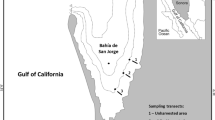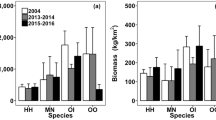Abstract
In the last decade, exploitation of Lessonia nigrescens in northern Chile has been carried out using the best practices agreed upon by consensus between fishermen, industry, government, and scientists. These practices focus on the selective harvest of sporophytes to allow the maintenance of a reproductive stock, facilitating recruitment and minimizing grazing of benthic herbivores. To improve coverage and accessibility, enforcement of administration measures along the northern coast of Chile requires ecological indicators to monitor the sustainability of Lessonia kelps. Over 2 years, density, biomass, recruitment, and size structure of Lessonia were sampled seasonally in coastal areas with different regimens of harvesting administration as follows: (1) Management Areas for Exploitation of Benthic Resources (MAEBR), (2) Open Access Areas (OAA), and (3) Marine Protected Areas without human intervention. The use of demographic parameters as ecological indicators allows discrimination between kelp beds where good harvesting practices have been applied by users (MAEBR), and areas where management recommendations have not been put in practice (OAA). The ecological indicators reinforced the concept of co-management in MAEBR as a viable harvesting administration system along the Chilean coast, and indicated a high-harvesting pressure in OAA. Moreover, together with other harvesting parameters, they could be useful to justify the application of other administration strategies, such as quotas or bans.








Similar content being viewed by others
References
Bixler HJ, Porse H (2011) A decade of change in the seaweed hydrocolloids industry. J Appl Phycol 23:321–335
Camus PA (1994) Recruitment of the intertidal kelp Lessonia nigrescens Bory in northern Chile: successional constraints and opportunities. J Exp Mar Biol Ecol 184:171–181
Castilla JC, Gelcich S, Defeo O (2007) Successes, lessons, and projections from experience in marine benthic invertebrate artisanal fisheries in Chile. In: McClanahan T, Castilla JC (eds) Fisheries management: progress toward sustainability. Blackwell, London, pp 25–42
Correa JA, Lagos N, Medina M, Castilla JC, Cerda M, Ramírez M, Martínez E, Faugeron S, Andrade S, Pinto R, Contreras L (2006) experimental transplants of the large kelp Lessonia nigrescens (Phaeophyceae) in high-energy wave exposed rocky intertidal habitats of northern Chile: Experimental, restoration and management applications. J Exp Mar Biol Ecol 335:13–18
Frangoudes K (2011) Seaweeds fisheries management in France, Japan, Chile and Norway. Cah Biol Mar 52:517–525
Garcia SM, Cochrane KL (2005) Ecosystem approach to fisheries: a review of implementation guidelines. ICES J Mar Sci 62:311–318
Gelcich S, Godoy N, Castilla JC (2009) Artisanal fishers' perceptions regarding coastal co-management policies in Chile and their potentials to scale-up marine biodiversity conservation. Ocean Coast Manag 52:424–432
González AV, Beltrán J, Hiriart-Bertrand L, Flores V, de Reviers B, Correa JA, Santelices B (2012) Identification of cryptic species in the Lessonia nigrescens complex (Phaeophyceae, Laminariales). J Phycol 48:1153–1165
González AV, Borras-Chavez R, Beltrán J, Flores V, Vásquez JA, Santelices B (2013) Morphological, ultrastructural, and genetic characterization of coalescence in the intertidal and shallow subtidal kelps Lessonia spicata and L. berteroana (Laminariales, Heterokonthophyta). J Appl Phycol. doi:10.1007/s10811-013-0112-6
Graham MH, Vásquez JA, Buschmann AH (2007) Global ecology of the giant kelp Macrocystis: from ecotypes to ecosystems. Oceanogr Mar Biol 45:39–88
Halpern BS, Cottenie K, Broitman BR (2006) Strong top-down control in Southern California kelp forest ecosystems. Science 312:1230–1232
Marín A, Gelcich S, Castilla JC, Berkes F (2012) Exploring social capital in Chile's coastal benthic co-management system using a network approach. Ecol Soc 17:13
Martínez EA, Cárdenas L, Pinto R (2003) Recovery and genetic diversity of the intertidal kelp Lessonia nigrescens (Phaeophyceae) 20 years after El Niño 1982/83. J Phycol 39:504–508
Omoregie E, Tjipute M, Murangi J (2010) Effects of harvesting of the Namibian kelp (Laminaria pallida) on the re-growth rate and recruitment. Afri J Food Agric Nutr Dev 10:2542–2555
Rodriguez D, Oróstica MH, Vásquez JA (2013) Coalescence in wild organism of the intertidal population of Lessonia berteroana in northern Chile: management and sustainability effects. J Appl Phycol. doi:10.1007/s10811-013-0121-5
Santelices B (1982) Bases biológicas para el manejo de Lessonia nigrescens (Phaeophyta, Laminariales) en Chile central. In: Castilla JC (ed) Segundo Seminario-Taller, Bases Biológicas para el uso y manejo de recursos naturales renovables: Recursos Biológicos marinos. Monografías Biológicas 2:135–150
Santelices B, Ojeda FP (1984) Recruitment, growth and survival of Lessonia nigrescens (Phaeophyta) at various tidal levels in exposed habitats of central Chile. Mar Ecol Prog Ser 19:73–82
Santelices B, Castilla JC, Cancino J, Schmiede P (1980) Comparative ecology of Lessonia nigrescens and Durvillaea antartica (Phaeophyta) in central Chile. Mar Biol 59:119–132
Seeley RH, Schlesinger WH (2012) Sustainable seaweed cutting? The rockweed (Ascophyllum nodosum) industry of Maine and the Maritime Provinces. Ann N Y Acad Sci 1249:84–103
Sokal RR, Rohlf FJ (1981) Biometry, 2nd edn. WH Freeman and Company, San Francisco
Subsecretary of Fishing and Aquaculture (2012) Propuesta de plan de manejo de algas pardas Región de Atacama. 73 pp. www.subpesca.cl
Tapia C (2002) Variables claves para el manejo de las pesquerías bentónicas de pequeña escala en la zona norte de Chile. Reporte técnico FIP 2001–25. 25 pp. www.cesso.cl
Tellier F, Vega JMA, Broitman B, Vásquez JA, Valero M, Faugeron S (2011) The importance of having two species instead of one in kelp management: the Lessonia nigrescens species complex. Cah Biol Mar 52:455–465
Thiel M, Macaya EC, Acuna E, Arntz WE, Bastias H, Brokordt K, Camus PA, Castilla JC, Castro LR, Cortes M et al (2007) The Humboldt current system of northern and central Chile: oceanographic processes, ecological interactions and socioeconomic feedback. Oceanogr Mar Biol 45:195–344
Thompson SA, Knoll H, Blanchette CA, Nielsen KJ (2010) Population consequences of biomass loss due to commercial collection of the wild seaweed Postelsia palmaeformis. Mar Ecol Prog Ser 413:17–31
Tognelli MF, Fernández M, Marquet PA (2009) Assessing the performance of the existing and proposed network of marine protected areas to conserve marine biodiversity in Chile. Biol Conserv 142:3147–3153
Vásquez JA (1995) Ecological effects of brown seaweed harvesting. Bot Mar 38:251–257
Vásquez JA (2008) Production, use and fate of Chilean brown seaweeds: re-sources for a sustainable fishery. J Appl Phycol 20:457–467
Vásquez JA (2013) Implementación de un sistema de auto-atención electrónica, para la acreditación de origen de recursos pesqueros. Informe Avance Proyecto 11BPC-10060
Vásquez JA, Santelices B (1984) Comunidades de macroinvertebrados en discos adhesivos de Lessonia nigrescens Bory (Phaeophyta) en Chile central. Rev Chil Hist Nat 57:131–154
Vasquez JA, Santelices B (1990) Ecological effects of harvesting Lessonia (Laminariales, Phaeophyta) in central Chile. Hydrobiologia 204:41–47
Vásquez JA, Vega JMA (2004) Ecosistemas marinos costeros del Parque Nacional Bosque Fray Jorge. In: Squeo FA, Gutiérrez JR, Hernández IR (eds) Historia Natural del Parque Nacional Bosque Fray Jorge. Ediciones Universidad de La Serena, La Serena-Chile, pp 235–252
Vásquez JA, Westermeier R (1993) Limiting factors in optimizing seaweed yield in Chile. Hydrobiologia 260/261:313–320
Vásquez JA, Piaget N, Vega JMA (2012) Chilean Lessonia nigrescens fishery in northern Chile: how do you harvest is more important than how much do you harvest. J Appl Phycol 24:417–426
Vásquez JA, Vega JMA, Buschmann AH (2006) Long term variability in the structure of kelp communities in northern Chile and the 1997–98 ENSO. J Appl Phycol 18:505–519
Vega JMA, Vásquez JA, Buschmann AH (2005) Population biology of the subtidal kelps Macrocystis integrifolia and Lessonia trabeculata (Laminariales, Phaeophyceae) in an upwelling ecosystem of northern Chile: Interannual variability and El Niño 1997–1998. Rev Chil Hist Nat 78:33–50
Ugarte R (2011) An evaluation of the mortality of the brown seaweed Ascophyllum nodosum (L.) Le Jol. produced by cutter rake harvests in southern New Brunswick, Canada. J Appl Phycol 23:401–407
Ugarte R, Sharp G (2012) Management and production of the brown algae Ascophyllum nodosum in the Canadian maritimes. J Appl Phycol 24:409–416
Westermeier R, Muller DG, Gómez I, Rivera P, Wenzel H (1994) Population biology of Durvillaea antarctica and Lessonia nigrescens (Phaeophyta) on the rocky shores of southern Chile. Mar Ecol Prog Ser 110:187–194
Wootton JT, Pfister CA (2013) Experimental separation of genetic and demographic factors on extinction risk in wild populations. Ecology. doi:10.1890/12-1828.1
Acknowledgments
JMAV would like to thank the Universidad Católica del Norte and the Comisión Nacional de Investigación Científica y Tecnológica (CONICYT) for scholarship to attend Ph.D. Program in Applied Biology and Ecology Universidad Católica del Norte (Coquimbo, Chile). JAV would like to thank COPRAM and Fondo de Investigación Pesquera (FIP) for financing studies associated with the commercial importance of brown macroalgae along the coast of northern Chile. Two anonymous reviewers greatly improve the original manuscript.
Author information
Authors and Affiliations
Corresponding author
Rights and permissions
About this article
Cite this article
Vega, J.M.A., Broitman, B.R. & Vásquez, J.A. Monitoring the sustainability of Lessonia nigrescens (Laminariales, Phaeophyceae) in northern Chile under strong harvest pressure. J Appl Phycol 26, 791–801 (2014). https://doi.org/10.1007/s10811-013-0167-4
Received:
Revised:
Accepted:
Published:
Issue Date:
DOI: https://doi.org/10.1007/s10811-013-0167-4




